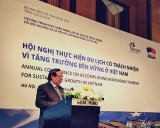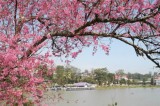The region is endowed with many beautiful scenic spots. The tourism cooperative program “Through Viet Bac heritage sites” has recorded encouraging results after 8 years of implementation and motivated regional tourism.
From 2009 to 2015, Viet Bac region received about 33 million tourists, an annual increase of 16%.
By July this year, 6 provinces have 1,200 hotels, one fourths of them are classified as 1 to 4-star hotels. Total investment in tourism was estimated at VND35 trillion.
Deputy Director General of the Vietnam National Administration of Tourism Ngo Hoai Chung said, “The 6 northern provinces have great potential for tourist development. First we need to identify the role of state management and local administration in tourist development."
"Localities, which want to develop enterprises and tourism products, should adopt appropriate policies to attract strategic investors and projects as a locomotive for tourism development,” he said.
The tourism cooperative program “Through Viet Bac heritage sites” has positively impacted tourism in 6 northern provinces.
The remote Ha Giang province has become a popular destination with many attractions such as the Lung Cu flag pole, Dong Van Stone Plateau, Buckwheat flower Festival, Dong Van market fair, and Na Trao cultural and tourist village.
From 2009 to 2015 Ha Giang received more than 3.2 million visitors, including 662,000 foreigners.
Lam Tien Manh, Deputy Director of the Ha Giang provincial Department of Culture, Sports, and Tourism, said, “Viet Bac provinces has taken advantages of their diverse heritages, particularly the culture of local ethnic groups. Ha Giang has cooperated with other provinces to develop interprovincial tours. We have invited prestigious investors to engage in tourism projects.”
Every year, provinces take turn to host the “Through Viet Bac heritage sites” program with diverse and jubilant activities.
Tran Kien Cuong, Director of Project Development of VinGroup, expected Viet Bac provinces to have regular community activities. A highway connecting 6 regional provinces will be built to facilitate tourism development.
Joining the tourism cooperative programs, localities have identified their advantages and disadvantages in order to adjust their development plan and replicate successful models.
Pham Minh Huan, Chairman of Tuyen Quang province, said, “Cooperation among provinces is very important. The local administration is responsible for managing tourism development. Tuyen Quang has chosen tourism as one of the spearhead sectors along with industry and commercial agriculture.”
















